/ News

The Most Futuristic Predictions That Came True In 2014
As 2014 comes to a close, it's time to reflect on the most futuristic breakthroughs and developments of the past year. This year's crop features a slew of incredible technological, scientific, and social achievements, from mind-to-mind communication to self-guiding sniper bullets. Here are 15 predictions that came true in 2014.
Technologically-assisted telepathy was successfully demonstrated in humans
For the first time ever, two humans exchanged thoughts via mind-to-mind communication.
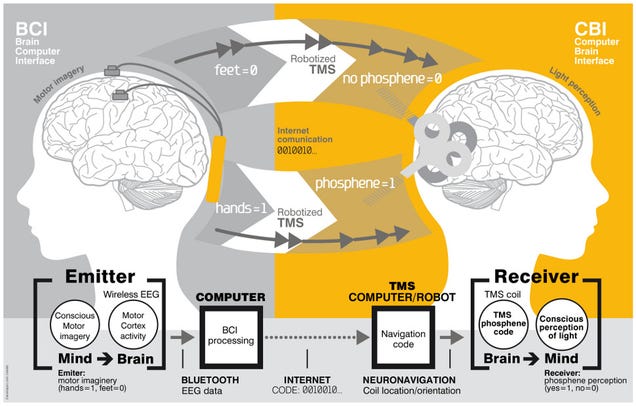
Remarkably, the system is completely non-invasive. By using internet-linked electroencephalogram (EEG) and robot-assisted image-guided transcranial magnetic stimulation (TMS) technologies, an international team of researchers were able to get two subjects — one in India and one in France — to mentally transmit the words "hola" and "ciao." It's an important proof of concept for furthering the development of tech-enabled telepathy. Image: Carles Grau et al/Plos.
And in a similar breakthrough, a different team developed a system that allowed a human subject to control the movements of another person. The University of Washington researchers showcased the technology by having participants collaborate on a computer game where a "sender" sent mental instructions to a "receiver" to control their hand movements.
NASA emailed a wrench to the space station
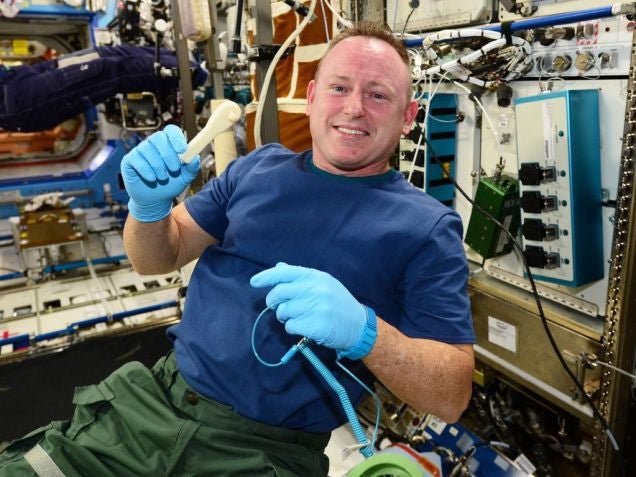
In what's being seen as a precursor to a Star Trek-like replicator, astronauts aboard the ISS used their 3D printer to manufacture a socket wrench. Remarkably, the 20-part wrench was designed on Earth and emailed to astronaut Barry Wilmore who ran it through the printer. It's a prime example of how 3D printing is poised to change space travel, allowing astronauts to produce equipment on demand and in emergency situations. Image: NASA.
Relatedly, British fighter jets are now flying with 3D-printed parts, while surgeons were able to reconstruct a man's face using a 3D printer.
British Fighter Jets Are Flying With 3D-Printed Parts
BAE Systems, which helps the UK's RAF put together its aircraft, has revealed that some… Read more gizmodo.com
Surgeons began using suspended animation
It's still in the trial stage, but this a remarkable achievement nonetheless. Surgeons at UPMC Presbyterian Hospital are using suspended animation — or what they call emergency preservation and resuscitation — to dramatically cool down trauma victims to keep them alive during critical operations.

The technique, which is only being used on patients who would otherwise be expected to die, involves internal rather than external cooling. The patient's blood is replaced with a cold saline solution, which slows down the body's metabolic functions and need for oxygen. Image: Prometheus.
The U.S. Navy deployed a functional laser weapon
The device, called a High Energy Laser (HEL) weapon, was fitted to the USS Ponce, which is currently on exercises in the Persian Gulf.

It's still at the prototype stage, but it's being fielded to evaluate its capabilities in a real-world environment where it has already shown its effectiveness in destroying two boats and a drone. Image: U.S. Navy.
Scientists "uploaded" a worm's mind into a robot
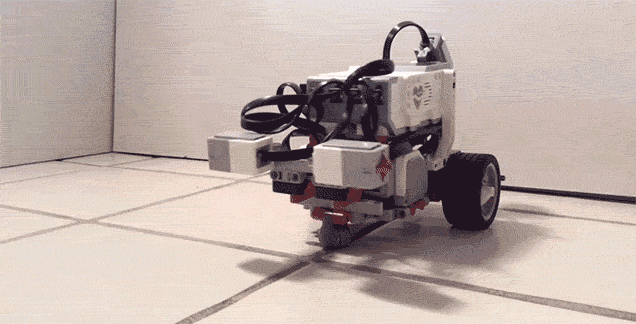
Researchers at the OpenWorm project are trying to create a digital version of an actual nemotode worm in a computer. They're not quite there yet, but that didn't stop team member Timothy Busbice from creating software that mimics the natural processes of the worm's neural networks — and then putting that knowledge in a LEGO Mindstorms EV3 robot.
This Could Be the First Animal to Live Entirely Inside a Computer
Animals are exceptionally complicated things. So complicated, in fact, that we've never… Read more
"My research takes the way the worm's brain is wired and extends it to a robot for sensory input and motor output," Buspice told Gizmodo. "What we found is that rather than just random, crazy movements by the robot, it actually responded to its environment in the same manner as the biological worm."
A computer solved a math problem that we can't check
Mathematician Steven Strogatz once predicted that computer-assisted solutions to math problems will eventually extend beyond human comprehension. His prediction appears to have finally come true.

Earlier this year, a computer solved the longstanding Erdős discrepancy problem. Unfortunately, human mathematicians aren't entirely sure about the solution because it's as long as all of Wikipedia's pages combined.
An artificial chromosome was built from scratch

In what was the year's biggest artificial life breakthrough, researchers from New York University Langone Medical Center reconstructed a synthetic and fully functional yeast chromosome. Incredibly, they were also able to insert their own special additions to the chromosome, including a chemical switch that allows scientists to "scramble" it into thousands of different variations to make subsequent gene editing even easier. It's an important proof of concept that could lead to designer organisms and artificial chromosomes in humans.
A venture capitalist firm appointed an AI to the board
Some say it was a media stunt, but it might be the start of a larger trend: Hong Kong-based Deep Knowledge ventures appointed a machine learning program, called VITAL, to its board of directors. It's said to be an "equal member" that will uncover trends "not immediately obvious to humans" in order to make investment recommendations. The system will pour over massive data sets, apply machine learning, and then predict which life sciences companies are the best investments.
And in related news, a robot "journalist" was the first to report on the Los Angeles Earthquake.
A Robot Was The First To Report On The L.A. Earthquake
This past Monday, the Los Angeles Times was the first media outlet to report on the 4.7 magnitude… Read more
A double amputee received two mind-controlled arms

Les Baugh became the first human to ever receive two shoulder-level thought-controlled prosthetic arms. It's not permanent, but the researchers at Johns Hopkins are hoping that the arms will eventually become a permanent add-on.
In other major cybernetic breakthroughs, researchers created an artificial hand that feels, and the first mind-controlled prosthetic hand with 10 degrees of freedom. Also, these wearable limbs took us a step closer to creating Doctor Octopus.
This cybernetic hand is the first to give amputees a sense of touch
You're looking at LifeHand2, a prosthetic limb that allows amputees to feel sensory-rich… Read more
A cloaking device that hides objects in the visible spectrum
We've seen so-called invisibility cloaks before, but nothing quite like this one.

Researchers at the University of Rochester developed a cheap and surprisingly effective cloaking device that's being heralded as the first to perform 3D, continuously multidirectional cloaking in the visible spectrum of light. To do it, they combined four standard optical lenses that keeps an object hidden — even as the viewer moves side to side. The system could eventually be used to eliminate blind spots in vehicles or let surgeons see through their hands during surgery. Photo credit: J. Adam Fenster / University of Rochester.
Gender-neutral pronouns came to North America
Vancouver's school board introduced the gender neutral pronouns "xe," "xem," and "xyr," in an effort to accommodate students for whom gender-specific pronouns doesn't fit or is considered inappropriate. The move is similar to measures enacted in Sweden and Germany.
Will Sweden abolish the concept of gender?
Sweden, it would seem, is doing its darndest to abolish the idea of gender. Their latest effort… Read more
An orangutan became a legally recognized person

In an important precedent that could influence law elsewhere, a 29-year-old Sumatran orangutan held at an Argentinian zoo was granted the right of habeas corpus, or bodily autonomy. As noted by AFADA lawyer Paul Buompadre, "This opens the way not only for other Great Apes, but also for other sentient beings which are unfairly and arbitrarily deprived of their liberty in zoos, circuses, water parks and scientific laboratories." Sandra will be released from the zoo and transfered to a sanctuary.
Self-guiding sniper bullets became a reality
The DARPA-funded system, called EXACTO, features a .50-caliber sniper round that can be optically guided to a target with a laser. Incredibly, the bullet can hit a target up to 1.2 miles (1.9 km) away.
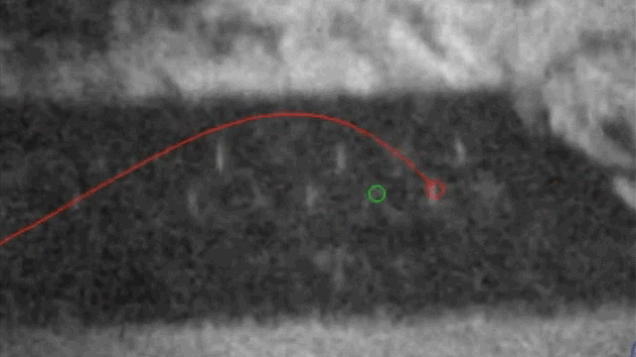
The technology was developed by Teledyne Scientific and Imaging, who disclosed virtually no information as to how the bullet maneuvers mid-trajectory.
A proto-cyber war erupted between the U.S. and N. Korea
It all started because of a very silly movie, but the consequences — and potential implications — are anything but. The Sony Hacks were directly linked to North Korea (an accusation that's still being contested), resulting in the temporary cancellation of The Interview's theatrical release. Shortly afterward, North Korea's entire Internet was taken down, allegedly by the United States. The world thus caught its first glimpse of what a cyber war might actually look like.
Humanity landed a robot on a comet
We've sent robotic probes to planets, but we've never done anything quite like this before.
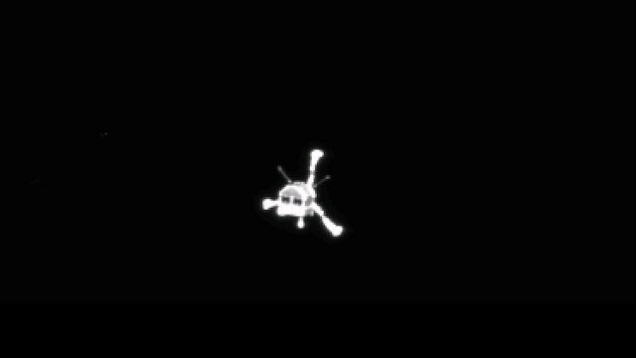
Philae's harrowing landing on Comet 67P in early November wasn't perfect, but the mission is being hailed as a wild success. In addition to some incredible images, we're learning about organic compounds on the comet and weird water that's potentially upending our theories of where our oceans came from. Image: ESA.
Source: http://io9.com/the-most-futuristic-predictions-that-came-true-in-2014-1674887659?utm_campaign=socialflow_io9_facebook&utm_source=io9_facebook&utm_medium=socialflow
/ About us
Founded by Russian entrepreneur Dmitry Itskov in February 2011 with the participation of leading Russian specialists in the field of neural interfaces, robotics, artificial organs and systems.
The main goals of the 2045 Initiative: the creation and realization of a new strategy for the development of humanity which meets global civilization challenges; the creation of optimale conditions promoting the spiritual enlightenment of humanity; and the realization of a new futuristic reality based on 5 principles: high spirituality, high culture, high ethics, high science and high technologies.
The main science mega-project of the 2045 Initiative aims to create technologies enabling the transfer of a individual’s personality to a more advanced non-biological carrier, and extending life, including to the point of immortality. We devote particular attention to enabling the fullest possible dialogue between the world’s major spiritual traditions, science and society.
A large-scale transformation of humanity, comparable to some of the major spiritual and sci-tech revolutions in history, will require a new strategy. We believe this to be necessary to overcome existing crises, which threaten our planetary habitat and the continued existence of humanity as a species. With the 2045 Initiative, we hope to realize a new strategy for humanity's development, and in so doing, create a more productive, fulfilling, and satisfying future.
The "2045" team is working towards creating an international research center where leading scientists will be engaged in research and development in the fields of anthropomorphic robotics, living systems modeling and brain and consciousness modeling with the goal of transferring one’s individual consciousness to an artificial carrier and achieving cybernetic immortality.
An annual congress "The Global Future 2045" is organized by the Initiative to give platform for discussing mankind's evolutionary strategy based on technologies of cybernetic immortality as well as the possible impact of such technologies on global society, politics and economies of the future.
Future prospects of "2045" Initiative for society
2015-2020
The emergence and widespread use of affordable android "avatars" controlled by a "brain-computer" interface. Coupled with related technologies “avatars’ will give people a number of new features: ability to work in dangerous environments, perform rescue operations, travel in extreme situations etc.
Avatar components will be used in medicine for the rehabilitation of fully or partially disabled patients giving them prosthetic limbs or recover lost senses.
2020-2025
Creation of an autonomous life-support system for the human brain linked to a robot, ‘avatar’, will save people whose body is completely worn out or irreversibly damaged. Any patient with an intact brain will be able to return to a fully functioning bodily life. Such technologies will greatly enlarge the possibility of hybrid bio-electronic devices, thus creating a new IT revolution and will make all kinds of superimpositions of electronic and biological systems possible.
2030-2035
Creation of a computer model of the brain and human consciousness with the subsequent development of means to transfer individual consciousness onto an artificial carrier. This development will profoundly change the world, it will not only give everyone the possibility of cybernetic immortality but will also create a friendly artificial intelligence, expand human capabilities and provide opportunities for ordinary people to restore or modify their own brain multiple times. The final result at this stage can be a real revolution in the understanding of human nature that will completely change the human and technical prospects for humanity.
2045
This is the time when substance-independent minds will receive new bodies with capacities far exceeding those of ordinary humans. A new era for humanity will arrive! Changes will occur in all spheres of human activity – energy generation, transportation, politics, medicine, psychology, sciences, and so on.
Today it is hard to imagine a future when bodies consisting of nanorobots will become affordable and capable of taking any form. It is also hard to imagine body holograms featuring controlled matter. One thing is clear however: humanity, for the first time in its history, will make a fully managed evolutionary transition and eventually become a new species. Moreover, prerequisites for a large-scale expansion into outer space will be created as well.
Key elements of the project in the future
• International social movement
• social network immortal.me
• charitable foundation "Global Future 2045" (Foundation 2045)
• scientific research centre "Immortality"
• business incubator
• University of "Immortality"
• annual award for contribution to the realization of the project of "Immortality”.



 LinkedIn
LinkedIn
 LiveJournal
LiveJournal
 Google
Google
 Twitter
Twitter
 Facebook
Facebook
 Я.ру
Я.ру
 ВКонтакте
ВКонтакте
 Mail.ru
Mail.ru